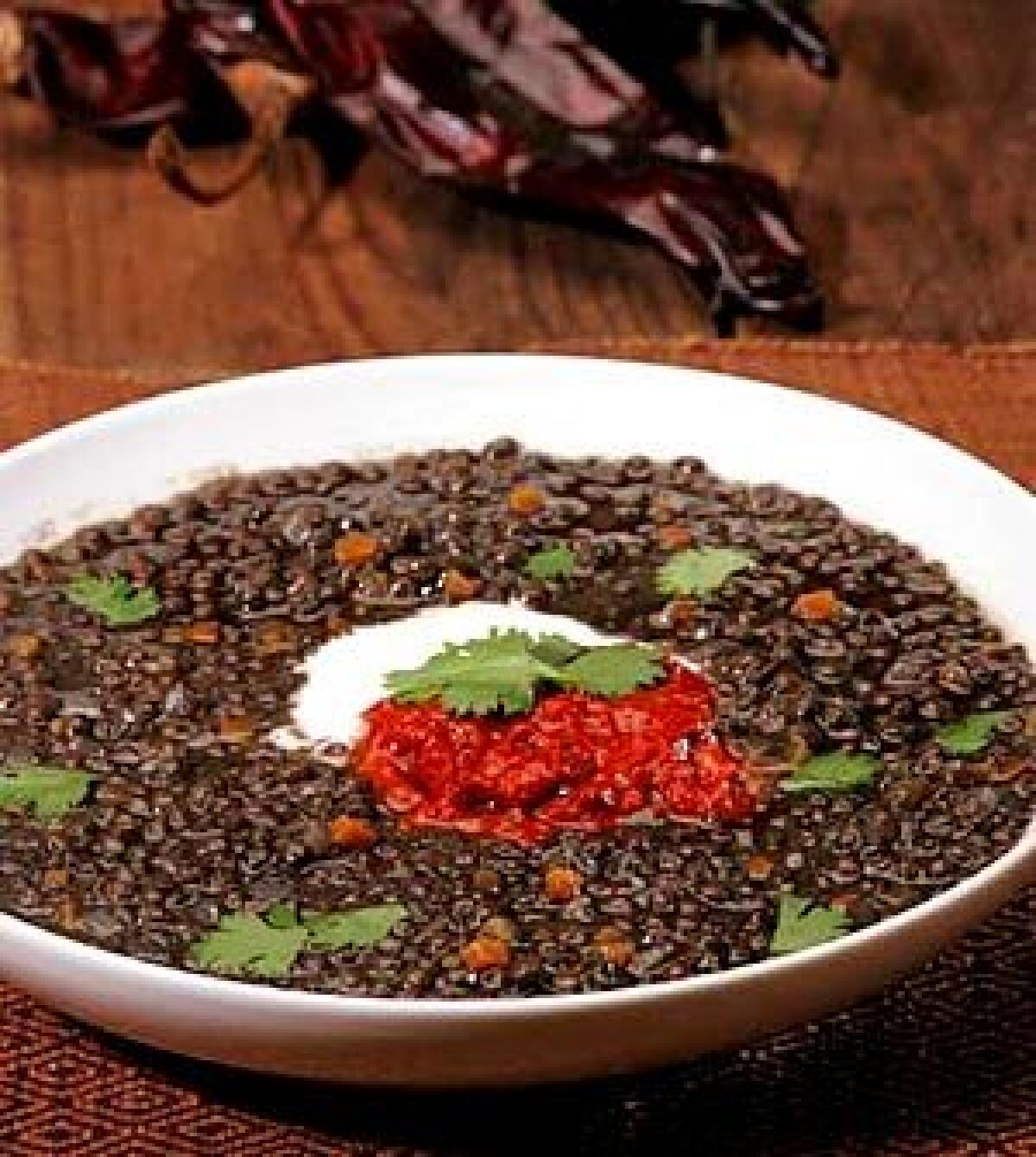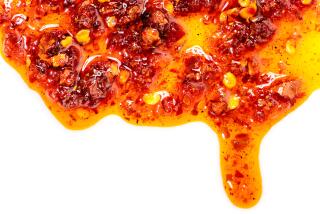Harissa, mon amour

This is an ode to harissa. It’s replaced my ketchup, my salsa picante, even (gasp) my Louisiana hot sauce. I put it on everything. Well, not exactly everything, but the potent North African chile sauce goes into my bean soups and sandwiches, it spikes my aioli and tops my pizzas. I even take it on road trips, as a kind of food insurance, where it’s done wonders for roadside hamburgers and omelets, even stadium Dodger dogs.
I owe the invention of my favorite hot sauce to the spice traders who brought chiles back from the New World to Tunisia, Algeria and Morocco. But these days our spice traders are on the Internet, where you can find a huge variety of harissas, from mild tomato-y tubes of it to breathtakingly hot versions to marquee mixes laced with rose petals. Although many of these are good, it’s hard to beat the stuff I make myself. With terrific dried chiles readily available and the food processor a handy substitute for the traditional mortar and pestle, there’s no reason to squeeze your harissa out of a tube either.
Although you can make harissa out of virtually any dried chile that suits your personal heat index, most traditional harissas use chiles that are only about as hot as anchos or pasillas. Guajillo and New Mexico chiles, according to cookbook author Paula Wolfert, are the closest to the peppers of Nabeul and Gabès in Tunisia. Use one or both, or add a few chipotle chiles into the mix: The smokiness of the chipotles adds a terrific earthy note. Or, if you like more heat, add a generous handful of chiles de árbol or even some red-hot Thai chiles -- the flavors will mellow a bit, though not that much.
Put the dried chiles into a bowl, cover with boiling water and allow them to soften for half an hour. Though many recipes call for warm or even tepid water, rehydrating chiles in boiling water softens up their papery skin and allows them to blend more easily, resulting in a smoother paste.
While your chiles are softening, grind coriander and caraway seeds in a spice grinder or a coffee grinder dedicated to grinding spices, or use a mortar and pestle. This is worth the effort, as pre-ground spices, like pre-ground coffee, often have lost much of their flavor. After the chiles are rehydrated, seed and stem them; be sure to wear rubber or latex gloves, as the oils from the peppers can irritate your skin and remain, like incendiary fingerprints, on your hands.
Then blend the chiles, spices, garlic and salt in a food processor with some olive oil and maybe a little water. Resist the urge to add too much oil; harissa, once finished, is stored with a layer of oil covering the top, so some of that will get mixed in over the course of its use. (Covered like this, it will keep for months in your refrigerator.)
At this point, you have a fantastic harissa -- hot but not scorching, the flavors of the various chiles marrying with the garlic and the spices to create a sauce that has plenty of heat, but also a surprising complexity. Although it’s ready to go at this point, the flavors will deepen and marry and mellow a bit in the process; for this reason, making your harissa a day before you want it, particularly if you’re using very hot chiles, may be worthwhile.
Harissas vary widely from region to region, so there isn’t really a definitive recipe. The most basic, using just dried chiles, a few spices, garlic, salt and olive oil, is traditional -- but even this is open to debate.
After you’ve made the basic harissa, you can also vary the flavor profile if you want -- adding cilantro and dried mint to the chile paste, as cookbook author and historian Claudia Roden suggests. Or freshly ground cumin, fresh chiles or onions, a dash of lemon juice -- even preserved lemon.
Many cooks add tomatoes, either sun-dried and rehydrated or canned, or roasted red bell peppers to the mixture to further round out the potent flavors of the chiles. Try adding some of both, for a lovely, nuanced sauce that combines the rich, jammy notes of the tomatoes with the lighter, more floral register of the bell peppers.
Harissa is both an ingredient and a condiment. Stir a spoonful or two into a couscous or tagine as it simmers, then thin some out with a little water so it has the consistency of a thick sauce, and serve it at the table for people to stir into their bowls. Use harissa to torque up a spaghetti sauce or a minestrone as it simmers, use it as a rub for fish to go on the grill, or thin it out and use as a marinade for chicken or lamb.
As a condiment, just about anything goes. Harissa is a great sauce for roast chicken or grilled steak. Spread a thin layer on a roasted vegetable sandwich or an ahi tuna panini, or use it instead of ketchup on a coriander-laced lamb burger. Slather it on a taco. Thin it to the consistency of salsa verde or stir it into yogurt, and you’ve got a splendid dipping sauce for flatbreads or crudités. You can even use it to spice up mayonnaise.
I’m thinking tonight I’ll make a simple, kohl-black beluga lentil soup. A dollop of tart Greek yogurt, a few leaves of fresh cilantro, then I’ll swirl in a spoonful of fiery red tomato-pepper harissa.
That is all I know on earth, and all I need to know. Or eat.
More to Read
Sign up for our L.A. Times Plants newsletter
At the start of each month, get a roundup of upcoming plant-related activities and events in Southern California, along with links to tips and articles you may have missed.
You may occasionally receive promotional content from the Los Angeles Times.







